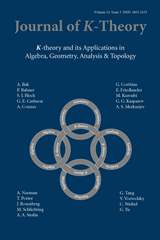Article contents
On principal bundles over a projective variety defined over a finite field
Published online by Cambridge University Press: 26 October 2009
Abstract
Let M be a geometrically irreducible smooth projective variety, defined over a finite field k, such that M admits a k-rational point x0. Let  (M,x0/ denote the corresponding fundamental group-scheme introduced by Nori. Let EG be a principal G-bundle over M, where G is a reduced reductive linear algebraic group defined over the field k. Fix a polarization ξ on M. We prove that the following three statements are equivalent:
(M,x0/ denote the corresponding fundamental group-scheme introduced by Nori. Let EG be a principal G-bundle over M, where G is a reduced reductive linear algebraic group defined over the field k. Fix a polarization ξ on M. We prove that the following three statements are equivalent:
1. The principal G-bundle EG over M is given by a homomorphism  (M,x0)→G.
(M,x0)→G.
2. There are integers b > a ≥ 1, such that the principal G-bundle (FbM)* EG is isomorphic to (FaM) * EG where FM is the absolute Frobenius morphism of M.
3. The principal G-bundle EG is strongly semistable, the degree(c2(ad(EG))c1 (ξ)d−2 = 0, where d = dimM, and the degree(c1(EG(χ))c1(ξ)d−1) = 0 for every character χ of G, where EG(χ) is the line bundle over M associated to EG for χ.
In [16], the equivalence between the first statement and the third statement was proved under the extra assumption that dimM = 1 and G is semisimple.
- Type
- Research Article
- Information
- Copyright
- Copyright © ISOPP 2009
References
- 2
- Cited by


